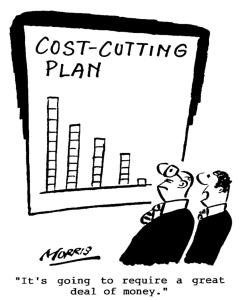This month we welcome this article from our associate, Richard Byford.
Not long ago I attended a meeting in a large military camp. Rather than have me lost amongst the buildings and corridors, my host asked a colleague to collect me from the car park. I was greeted by Andrew, a smartly turned-out naval officer.
As we walked across the acres of car park and between ranks of anonymous redbrick outhouses, we started chatting. He, apparently, had only been in the navy a couple of years, having previously worked for a brewery as a beer salesman. He joked that it seemed to him like a natural progression. Andrew asked me about my work and I explained how I helped public sector organisations choose suppliers and solutions for complex projects. With a smile, he told me his own story about a project where the procurement had not gone exactly as planned.
A government department had set out to buy a fleet of cars. They were fully aware of the need to minimise costs and equally eager to prove that they were being frugal with public money. A carefully controlled set of meetings was held, where the exact needs of the users were explored and duly recorded. Eventually, they had a full specification for the cars and set about approaching industry to get competitive bids.
The cars were to be used for business only not for cruising down country lanes in the sunshine; so they wouldn’t need sunroofs. Civil servants were quite capable of winding down windows by hand, so electric windows would be an extravagance (this was a long time ago…). All driving would be done in work time, cassette players were unnecessary simple radios could pick up the news and travel information. Other features considered to be expendable were ruthlessly eliminated from the specification. Civil servants would not be pampered at the expense of the public purse.
A short list of potential suppliers was identified and tender documents sent out, complete with the detailed specification. “We want a standard, five seat car, with no sunroof, manual window winder and a plain radio with no cassette player or plugs for gizmos.” The list contained a further dozen or so additional economies that would drive the price of the vehicles down. The procurement team sat back and happily awaited the bids. They wondered if they might get some sort of award from central government for all the hard work they had put in to driving the cost down.
The day arrived when all the bids were due back in. As is traditional in some of the older public authorities, the bids were blessed by a senior commercial officer, before being handed out to the Tender Assessment Board. There were visible signs of dismay on the faces of the officials as it became clear that all the bids were priced well above normal retail prices for the equivalent cars.
The very first phone call to one of the bidders explained why this was the case. “We will have to produce new tooling for some of the body panels to eliminate the cut out for the sun roof” a sales manager explained. “Then, we will also need to redesign the door to take a manual winder, as the standard model comes with electric windows. So far, we have not been able to track down a radio player that meets your specification, but a supplier in Taiwan says he can produce a batch without CDs or other features – provided we pay for his set up costs.” The explanation continued, with detailed explanations of redesign and retooling, line stoppages and changes to components.
I can’t vouch for the truth of this story. In re-telling it, I have probably added my own distortions. The important thing, though, is it demonstrates a dynamic that I have personally witnessed on dozens of real life public procurement projects. So was this down to the actions of lazy, careless and stupid civil servants? Well you might claim to have spotted some stupidity, but only with the benefit of hindsight. But can you honestly say that you would have noticed it if you were part of the team developing the requirements? Many of our greatest opportunities for cost savings are lost not by incompetence or carelessness but by people working too hard and trying to be clever.
Let’s turn the tables now and look at this from the bidders’ point of view: Industry loves solving problems. Most bidders are on a constant lookout for ways that they can use their resources, ingenuity and innovation to provide better, cheaper, solutions. It makes sense for them; it gives them the potential for differentiating their bid and making relatively greater profits, even from lower prices. Instead, their attempts to save the Taxpayers’ money are stymied by ‘clever’ civil servants constraining them to their own perception of what a good solution would look like.
As the Civil Service shrinks, its ability to specify half engineered solutions will diminish and I predict that more and more bizarre tender documents will hit industry as the staffing cuts take hold.
So what can you do, if you are a bidder? You have to be canny, quick and versatile. Firstly, find some way of engaging with public sector customers before a procurement competition starts. Once a tender is advertised, it is almost impossible to affect the contract award criteria. Secondly, ask questions, using the formal channels of communication, to probe the rigidity of the specifications. Rather than challenge the specification, ask probing questions such as “Why is that of particular interest to the Authority?” or “what benefit does the Authority believe it will produce?” Both of these questions will allow you to suggest alternative ways of satisfying their needs: ‘So if we could produce the same benefits using an alternative method, would that be acceptable?’
The future relationship between industry and the public sector will be critical to maintaining public services in the face of draconian budget cuts. It’s time for government to recognise that real savings can only be realised when Industry is free to innovate when bidding for public contracts. Forget the specifications; let’s talk about needs and solutions.
Please let us know if you would like to discuss this issue further with Richard.



